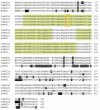Expression of Camelina WRINKLED1 Isoforms Rescue the Seed Phenotype of the Arabidopsis wri1 Mutant and Increase the Triacylglycerol Content in Tobacco Leaves
- PMID: 28174580
- PMCID: PMC5258696
- DOI: 10.3389/fpls.2017.00034
Expression of Camelina WRINKLED1 Isoforms Rescue the Seed Phenotype of the Arabidopsis wri1 Mutant and Increase the Triacylglycerol Content in Tobacco Leaves
Abstract
Triacylglycerol (TAG) is an energy-rich reserve in plant seeds that is composed of glycerol esters with three fatty acids. Since TAG can be used as a feedstock for the production of biofuels and bio-chemicals, producing TAGs in vegetative tissue is an alternative way of meeting the increasing demand for its usage. The WRINKLED1 (WRI1) gene is a well-established key transcriptional regulator involved in the upregulation of fatty acid biosynthesis in developing seeds. WRI1s from Arabidopsis and several other crops have been previously employed for increasing TAGs in seed and vegetative tissues. In the present study, we first identified three functional CsWRI1 genes (CsWRI1A. B, and C) from the Camelina oil crop and tested their ability to induce TAG synthesis in leaves. The amino acid sequences of CsWRI1s exhibited more than 90% identity with those of Arabidopsis WRI1. The transcript levels of the three CsWRI1 genes showed higher expression levels in developing seeds than in vegetative and floral tissues. When the CsWRI1A. B, or C was introduced into Arabidopsis wri1-3 loss-of-function mutant, the fatty acid content was restored to near wild-type levels and percentages of the wrinkled seeds were remarkably reduced in the transgenic lines relative to wri1-3 mutant line. In addition, the fluorescent signals of the enhanced yellow fluorescent protein (eYFP) fused to the CsWRI1 genes were observed in the nuclei of Nicotiana benthamiana leaf epidermal cells. Nile red staining indicated that the transient expression of CsWRI1A. B, or C caused an enhanced accumulation of oil bodies in N. benthamiana leaves. The levels of TAGs was higher by approximately 2.5- to 4.0-fold in N. benthamiana fresh leaves expressing CsWRI1 genes than in the control leaves. These results suggest that the three Camelina WRI1s can be used as key transcriptional regulators to increase fatty acids in biomass.
Keywords: Camelina sativa; WRINKLED1; fatty acid; leaves; oil; triacylglycerol.
Figures









Similar articles
-
Splice Variants of the Castor WRI1 Gene Upregulate Fatty Acid and Oil Biosynthesis When Expressed in Tobacco Leaves.Int J Mol Sci. 2018 Jan 5;19(1):146. doi: 10.3390/ijms19010146. Int J Mol Sci. 2018. PMID: 29303957 Free PMC article.
-
Transcriptional transitions in Nicotiana benthamiana leaves upon induction of oil synthesis by WRINKLED1 homologs from diverse species and tissues.BMC Plant Biol. 2015 Aug 8;15:192. doi: 10.1186/s12870-015-0579-1. BMC Plant Biol. 2015. PMID: 26253704 Free PMC article.
-
Ectopic Expression of Perilla frutescens WRI1 Enhanced Storage Oil Accumulation in Nicotiana benthamiana Leaves.Plants (Basel). 2023 Feb 28;12(5):1081. doi: 10.3390/plants12051081. Plants (Basel). 2023. PMID: 36903941 Free PMC article.
-
Molecular Basis of Plant Oil Biosynthesis: Insights Gained From Studying the WRINKLED1 Transcription Factor.Front Plant Sci. 2020 Feb 4;11:24. doi: 10.3389/fpls.2020.00024. eCollection 2020. Front Plant Sci. 2020. PMID: 32117370 Free PMC article. Review.
-
WRINKLED1, a "Master Regulator" in Transcriptional Control of Plant Oil Biosynthesis.Plants (Basel). 2019 Jul 22;8(7):238. doi: 10.3390/plants8070238. Plants (Basel). 2019. PMID: 31336651 Free PMC article. Review.
Cited by
-
Characterisation of Grains and Flour Fractions from Field Grown Transgenic Oil-Accumulating Wheat Expressing Oat WRI1.Plants (Basel). 2022 Mar 26;11(7):889. doi: 10.3390/plants11070889. Plants (Basel). 2022. PMID: 35406869 Free PMC article.
-
Genome-Scale Analysis of the WRI-Like Family in Gossypium and Functional Characterization of GhWRI1a Controlling Triacylglycerol Content.Front Plant Sci. 2018 Oct 16;9:1516. doi: 10.3389/fpls.2018.01516. eCollection 2018. Front Plant Sci. 2018. PMID: 30386365 Free PMC article.
-
Molecular basis of the key regulator WRINKLED1 in plant oil biosynthesis.Sci Adv. 2022 Aug 26;8(34):eabq1211. doi: 10.1126/sciadv.abq1211. Epub 2022 Aug 24. Sci Adv. 2022. PMID: 36001661 Free PMC article.
-
Genome-Wide Mapping of Histone H3 Lysine 4 Trimethylation (H3K4me3) and Its Involvement in Fatty Acid Biosynthesis in Sunflower Developing Seeds.Plants (Basel). 2021 Apr 6;10(4):706. doi: 10.3390/plants10040706. Plants (Basel). 2021. PMID: 33917507 Free PMC article.
-
Advances in Understanding the Genetic Basis of Fatty Acids Biosynthesis in Perilla: An Update.Plants (Basel). 2022 Apr 29;11(9):1207. doi: 10.3390/plants11091207. Plants (Basel). 2022. PMID: 35567213 Free PMC article. Review.
References
-
- An D., Suh M. C. (2015). Overexpression of Arabidopsis WRI1 enhanced seed mass and storage oil content in Camelina sativa. Plant Biotechnol. Rep. 9 137–148. 10.1007/s11816-015-0351-x - DOI
-
- An G. (1987). Binary Ti vectors for plant transformation and promoter analysis. Methods Enzymol. 153 292–305. 10.1186/1472-6750-10-67 - DOI
LinkOut - more resources
Full Text Sources
Other Literature Sources
Molecular Biology Databases

